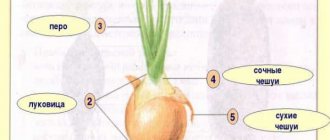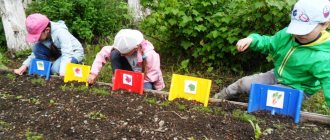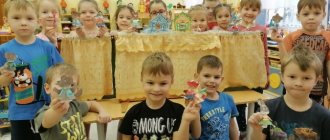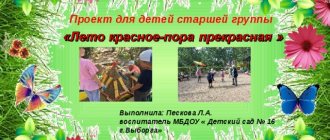MAGAZINE Preschooler.RF
Project “Journey to the World of Ants”Fedotova Lyubov Sergeevna teacher of MBDOU "Kindergarten No. 399" g.o. Samara.
Relevance of the project
The problem of environmental education is one of the fundamental problems of the theory of education and is of paramount importance for educational work. Educators of the last century attached great importance to nature as a means of educating children. So, Ya.I. Comenius saw in nature a source of knowledge, a means for the development of the mind, feelings and will.
In modern conditions, with the expansion of the scope of educational influence, the problem of environmental education is especially relevant. With the adoption of the laws of the Russian Federation “On Environmental Protection” and “On Education in the Russian Federation” , the prerequisites for the legal framework were created for the formation of a system of continuous environmental education, the first link of which is preschool education. Therefore, environmental education of the younger generation is one of the most important tasks of the entire public education system.
Preschool age is the most favorable period for a child’s emotional interaction with nature. This entails the task of developing a responsible attitude towards nature in children. And the sooner work on environmental education begins, the greater its pedagogical effectiveness will be.
Thus, preschool children, learning about the world around them and encountering the world of insects, react differently. Some are afraid of insects, others destroy them because they know little about the benefits of insects. This is explained by the fact that interest in the surrounding nature was not supported in time and, on the basis of a healthy interest, they were not introduced to the life of insects. Children cannot independently explain natural phenomena of interest, so this is the task of adults.
Observation is the main means of understanding nature. It makes it possible to introduce children to natural phenomena and the relationship between living and inanimate nature. It is observation that helps preschoolers see the changes that occur in plants depending on environmental conditions or those created by man. As a result of observation, children learn to analyze and compare.
While walking, the children saw an ant. The guys' reaction was mixed. Some children expressed joy and interest, others were scared. There were also guys who suggested destroying it. Opinions were divided. During the conversation, it became clear that knowledge about insects is scarce. Thus, the problem arose : “Are ants necessary? Do they bring benefit or harm? . Children's participation in the project allowed them to form ideas about insects, their benefits or harm, and develop creative abilities and search activities.
Goals and objectives of the work performed
Goal: developing ideas about the life of insects.
Tasks:
- To form in children elementary ideas about ants, their structure, and methods of movement.
- Foster a caring attitude towards living things and an interest in insects.
- Develop emotional responsiveness.
- Develop research skills.
Forms, methods of work, results
Working with parents on the project
Consultation “How to instill a love for nature”
Providing assistance in the selection of encyclopedias, literature, games.
Observation of ants with parents in different places and at different times.
Project products:
- Ant (modeling)
- Anthill (drawing)
Project portfolio
- Ecological album “Journey to the world of ants”
Expected result of the project:
For children:
- Children's caring attitude towards nature, in particular towards ants
- Development of cognitive activity and curiosity
For teachers:
- Development of children's communication skills, ability to work in a team
- Creating conditions for imagination
Expanding children's horizons through reading fiction, becoming familiar with proverbs, and learning poems.
For parents:
Joint reading of fiction about ants, watching the cartoon “How the Ant Hurried Home”
Involvement in cooperation to create conditions for children's cognitive and research interests
Stage I - Preparatory
- Diagnosis of ecological knowledge of ant insects.
- Selection of encyclopedias, magazines, literary works, illustrative material about insects, ants.
- Selection of didactic games (lotto, puzzles), toys and attributes for gaming activities.
- Drawing up a plan for the main stage.
Stage II - Main (project implementation)
1. Educational conversations on the topic
Purpose: to introduce the names of the parts of the ant’s body, to introduce them to the methods of nutrition, lifestyle, benefits or harms and significance for the lives of other inhabitants of nature.
2. Literary word, riddles about the ant, reading a fairy tale and watching the cartoon by V. Bianchi “How the ant hurried home . Reading I. Krylov’s fable “The Dragonfly and the Ant” .
Goal: to introduce children to literary works about the ant.
3. Walk “Observing ants” (searching for an anthill: observing insects on a walk, examining body parts through a magnifying glass).
Goal: consolidate knowledge about the ant’s home, how to protect anthills
4. GCD “From the life of ants”
Goal: consolidate and clarify children’s knowledge about the lifestyle of ants, habits, benefits, activate children’s vocabulary
5. Art activity “Who helped the ant get home” , “Anthill” , “Ant” (modeling).
Goal: To strengthen children’s visual skills by depicting an ant.
6. Game - dramatization based on the fairy tale by V. Bianchi “How an ant hurried home”
Goal: to consolidate children’s knowledge about the content of a fairy tale, develop speech,
artistic abilities.
7. Watching the cartoon “Dragonfly and the Ant”
8. Outdoor games “Bear and bees” , “Day and night” , “Ant and rain” .
III productive stage
Making an environmental album
Exhibition of creative works
conclusions
After conducting research, observing the life of ants, we learned who ants are, what the living conditions are, what anthills are built from, what functions each ant performs, what species exist, what is its role in nature. This gave the children a desire to communicate with nature.
Children learned to understand the need to take care of nature. Ants are a vivid example of hard work and mutual assistance. They are interesting for their complex social behavior. Ants know how to build, find water, give signals to each other, navigate by the sun, but they do not know how to live alone, like any person. So there was a desire to get more information about ants and other insects.
The importance of ants in nature is great. Therefore, it is necessary to protect and protect.
Literature:
- Alekseev V.A. “300 questions and answers on ecology” , Yaroslavl. -1998
- Alyabyeva E.A. “Thematic days and weeks in kindergarten” , Moscow 2008.
- Baranov, V. S. Research work in preschool educational institutions / V. S. Baranov // Preschool education. – 2009. – No. 4. – P. 23 – 24.
- Baulina, Yu. V. Observations in kindergarten / Yu. V. Baulina // Preschool education. – 2008. – No. 7. – P. 30 – 31.
- Zolotova E.I. “Introducing preschoolers to the natural world” , Moscow. — 1992
- The main general educational program of preschool education FROM BIRTH TO SCHOOL. Under. ed. Veraksy N.E., Komarova T. S., Vasilyeva M. A. – M., Mozaika – Synthesis, 2015
- Pichugina, N. O. Preschool pedagogy. Lecture notes / N. O. Pichugina. – Rostov n/d: Phoenix, 2004. – 384 p.
- Innovative orientation of a modern preschool educational institution / V. N. Abushaeva // Preschool education. – 2006. – No. 5. – P. 23 – 24.
- Shorygina T.A. Insects. What are they? M.: “GNOM and D” -2005.
- Coloring book Ant [Electronic resource]
| Next > |
In an individual research project in biology on the topic “Ants at home,” the student studied the theory of keeping ants at home, transferred ants from a test tube to a formicarium, and observed their behavior in different conditions.
More details about the work:
During the student research work on biology “Ants at home”, the influence of the habitat and feeding method on the life activity of ants and the development of the colony in a formicarium was examined.
An educational project in biology on the topic “Ants at home” contains information about favorable conditions for the life of ants and proper feeding of insects in a home formicarium; an observation and experiment was carried out on the interaction of harvester ants with ants of other species and other insects.
The materials of the research project can be used as an additional resource in preparation for biology lessons, as well as for independent study on the topic for the purpose of self-education and broadening one’s horizons in the field of biology and entomology.
Table of contents
Introduction 1. Who are ants? 2. Reaper ant at home. Conclusion References
Introduction
I love insects. I noticed that they surround us everywhere. In the summer at my grandmother's, I look with interest at all the insects that catch my eye. The most interesting thing is to look at the ants. Because they run and scurry tirelessly back and forth, constantly doing some kind of work. As soon as their anthill is touched and slightly damaged, vigorous work immediately begins to repair and strengthen their home. There are stones near grandma's house, and under them there are anthills.
My brother and I moved the stone a little and panic began and at the very top of the anthill there was almost not a single ant left. Then I noticed that we had red ants running around in the bathroom at home. Parents say that ants are pests in the home because they steal food and can carry some diseases. I don’t see them anywhere except this room, so I concluded: they live there because it’s humid.
These ants are also very small. Last year they were disinfected and they disappeared, but a year later they began to appear again. I began to wonder where their home is, how they spend the winter. I wanted to learn more about them: how the ant family works, do ants sleep, how do they breathe, what do they eat, what is tropholaxis , do ants hibernate in winter, who is the queen, why is the size of the queen so large, why are the sizes of ants in one anthill different, why some have wings and others don’t, how offspring appear and much more.
I asked my mom and dad to buy me an ant farm . And they gladly bought it for me.
Relevance of the chosen topic: the opportunity to observe and study the behavior of insects at home.
a goal for myself : to develop a colony of ants.
To do this, it is necessary to solve the following problems:
- study the literature on this issue;
- move ants from a test tube to a formicarium;
- provide favorable living conditions for ants and proper feeding;
- conduct observation and experiment;
- draw conclusions.
Object of study: ants.
Subject of research: formicarium.
Purpose of the work: to populate the ants in the formicarium, observe the behavior of the ants and increase the number of individuals in the colony.
Methods and techniques:
- studying literature, Internet sources and summarizing the information received;
- creating favorable conditions for the development of the colony;
- observation of the behavior and life of ants in a formicarium;
- conducting an experiment.
Data obtained: based on the data obtained, I was able to organize the life and development of ants in a formicarium.
Conclusions: the colony is developing, the research can be considered successful.
Go to section: 2. Who are ants?
Ant farm (formicarium) Ready business project. Part 1
I didn’t think that ants would become so popular, keep a ready-made business project. Print farms, catch ants. It all started with the desire to have a pet. Having suffered with fish and birds and all sorts of smelly rodents, I decided to get ants because... I wanted as little care as possible and a minimum of responsibility. They are a completely independent organization, they don’t care about the owner, they cook their own food, take out the trash themselves, don’t yell, don’t smell. Throw in some food, fill up with water and you don’t have to worry about them (Reaper ants), you can even leave for a long time without fear of dying from hunger or destroying your apartment, as was the case with my cat :)
Looking at an anthill is always interesting, you take your mind off everyday worries, think about the eternal... You observe your own microcosm, imagining that you are God for them:)
But experiments on them are a completely separate topic.
I designed the formicarium according to criteria from personal experience:
- The anthill must be vertical (to allow observation from different sides)
- Not large in size so that it does not take up much space on the desk (120x120x120mm)
- Built-in light (plays a very important role for putting children to sleep as a night light)
- Presentable appearance (well, I don’t like the plexiglass molds with bolts, somehow it’s not right IMHO)
- Can be assembled and disassembled without bolts or glue, but without the possibility of ants escaping.
Said, done... and then it started.
A bunch of unsuccessful farms and months of experiments until I achieved comfortable living for ants in a 3D printed formicarium. STL files for printing here If you want me to make it, write to me in a personal message.
Arena
There were options without an arena at all, but practice has shown that it is still needed. I adjusted the height of the arena so that the magnification lens for the phone could focus properly. The cover goes inside the arena to apply anti-escape along the edges of the arena. Pay attention to the back wall, there is a hole for the air plug, it needs to be cut out. If you do not want to attach a colonization tube or an additional arena, leave the wall as is, the gap in the lid is sufficient for air.
I made a hidden opener so that children would not be tempted to open the lid again. There is a hole at the bottom for a paper clip (it opens like a SIM card slot on a smartphone)
The air plug performs several functions at once. Ventilation and adapter for in vitro colonization. You can also connect to another arena (in case of war with other ants)
And of course the backlight. Here it’s your choice, if you don’t need it, don’t touch anything, leave it as is. I left one layer at the base for the batteries, which can be easily cut out.
If you need backlighting, cut out the battery compartments and connect them according to the diagram. There is a hole under the passage where the wires are inserted. The recesses for the terminals are precisely calculated to install the contact elements without glue, you can find them here. I used any LEDs from the LED strip, the main thing was to maintain the polarity. There is no hassle at all with the switch; you can find it in any radio store, or order it here.
I had to tinker with the lid. I made an arena for a lid with a size of 120x80mm, but the crooked glaziers could not cut the glass evenly. I had to make crutches for glaziers, that is, a frame for the lid, and this is for the better because... The appearance of the arena has become more presentable.
Any decorations can be printed. I personally really like the Egyptian pyramid theme. Previously, a decorative background was simply laid down and covered with sand. But the ants made tunnels and dug everything out, so now I’m filling it with plaster.
Now the most important thing. I print with PLA plastic, of course I tried ABS with an acetone bath and even wood. But during the experiments I settled on PLA plastic from FDplast, it prints wonderfully, is processed perfectly and the price is pleasantly pleasing. Each formicarium detail has its own settings and material; I print the arena with the following settings:
In order not to miss anything important, I posted screenshots of all my settings. It will seem strange to many to print with such settings, but as I said earlier, I achieved the best quality and accuracy of printing by adjusting the settings here and there for a long time, squeezing the maximum out of my printer. The arena print layer is 0.25mm, usually I print 0.15mm. But even with 0.25mm you get an excellent result. I don’t even sand the surface, only in the seam areas and along the edges.
The assembly video is here (I warn you, it’s very boring, put it at double rewind)))
Printable model here (or I can print and assemble the farm for your money)
In the next post I will tell you the intricacies of printing the anthill itself and the settlement procedure.
To be continued….






